Originally published on Wired.com
Virgin America launched its U.S. air service yesterday, and immediately staked a claim as the most geek-friendly airline yet invented. It’s also one of the most comfortable and pleasant to fly in — and it’s reasonably priced.
I flew in the inaugural flight from Los Angeles to San Francisco. Almost every aspect of the trip was pleasant, and the planes have clearly been designed by people with a keen sense of design and an appreciation of technology’s ability to make people feel comfortable and happy.
For notebook-toting travelers, the most welcome feature is 110-volt power, with two outlets in every set of three coach seats. There are also USB connectors for charging USB-powered devices like iPods and Razrs — although the ports don’t yet deliver enough current to charge an iPhone. Unfortunately these outlets are below the seats so you have to plug in by feel, since you can’t actually see them very clearly unless you get down on the floor.
Seats are the most comfortable coach class seats I’ve ever been in, with cushy padding and leather coverings, and there’s plenty of legroom. The cabin is illuminated with indirect “mood lighting” whose color shifts through 12 different hues, depending on the time of day, although it remained purple during my afternoon flight yesterday.
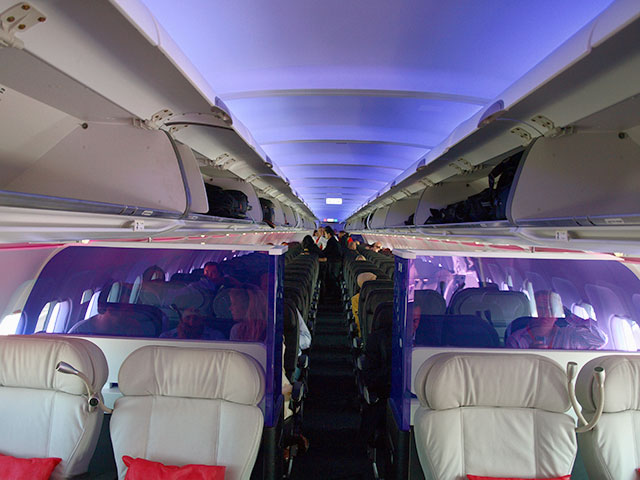
Each seat also has an RJ-45 (Ethernet) connector, but you won’t get internet access when you plug in today. Connectivity will have to wait until next year, when Virgin will begin offering internet access via Ethernet and via in-cabin Wi-Fi. The company still hasn’t decided which technology it will use to offer ground-to-air internet connections, according to Charles Ogilvie, the designer of the inflight system. Once that’s squared away, internet access will be available for an additional fee. Passengers may also have the option of choosing among varying connection speeds, with different fee levels, Ogilvie says.
The cabin is already outfitted with Wi-Fi, but it’s a secured network that passengers don’t have access to. The network currently is used by the in-flight entertainment system to connect the 9-inch display screens on every seat back to a set of 4 central servers. There’s also a control panel (running on a Motion Computing Tablet PC) that the flight attendants use to see what each passenger has ordered.
Those seat-back display screens are probably the most noticeable difference for most travelers. Each touch-sensitive screen is paired with a two-sided wired remote in the armrest. On one side of the remote are standard volume, channel, forward and back controls; on the other side is a QWERTY keyboard. There are shoulder buttons for playing games, and on the other side, a slot for swiping your credit card (which you’ll have to do plenty of, in order to pay for food, drink, and other amenities).
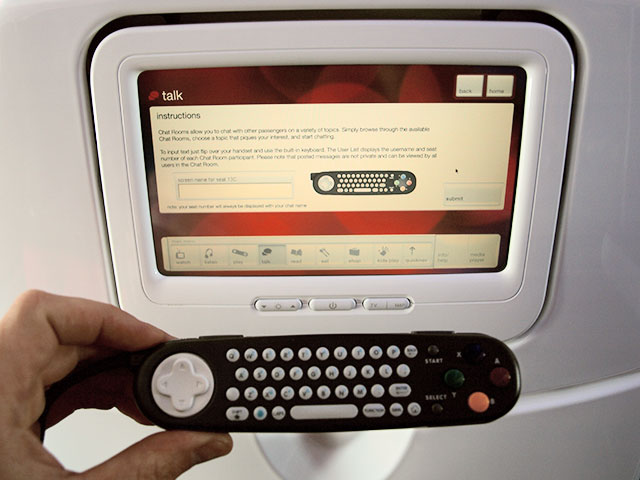
The inflight entertainment system’s best feature is its selection of pay-per-view movies (more than 30 to choose from, at $8 apiece), live satellite TV, and more than 3,000 music tracks. You can build a playlist of your favorite music and the system will remember it from flight to flight, so the next time you check in, your playlist will be waiting for you. Nice! (Of course, taking an iPod with you is another way to make sure you’ve always got your playlist.) The system also keeps track of what you’re watching so if you pause a movie to go listen to some music or check the scores on ESPN, you can resume the movie after you’re done.
You can use the screen to order food and drinks, or to text-chat with other passengers. And there’s a selection of games you can play, including Doom (the very first version — with positively archaic graphics), Mad Bomber, a Bejeweled clone, and many others. The games are pretty primitive, frankly, and they’re all single-player, although I’m told that multiplayer versions will be coming later. Now that would be cool: Even with its rudimentary graphics, Doom 1 could be pretty fun for fragging other passengers.
What seat-back display would be complete without a map showing where your plane is right at this second? Virgin America’s system has this feature, of course–and it’s based on Google Maps.
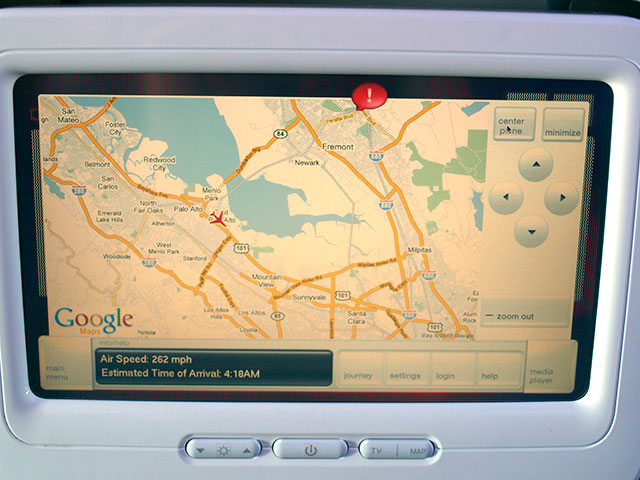
I managed to crash the inflight system by pushing some odd combination of buttons, but it rebooted gracefully (revealing that it’s running Red Hat Linux in the process) and was back online within five minutes.
Virgin gave me a complimentary seat on this flight so I wasn’t able to check out its reservation system, but the company is touting the user-friendliness of its web site and the simplicity of its reservation system. The fare structure is straightforward, based on one-way prices with no stayover requirements. A flight between San Francisco and Los Angeles (LAX) for the upcoming weekend currently costs $99 to $144 each way (coach class), while flights between San Francisco and New York’s JFK airport for the same weekend cost $269 to $399 each way.
Virgin currently only flies two flights daily between SFO and JFK and five a day between SFO and LAX. Between now and the end of October, the airline will add several more connections: Los Angeles-New York, San Francisco-Washington D.C., San Francisco-Las Vegas, and Los Angeles-Washington D.C.
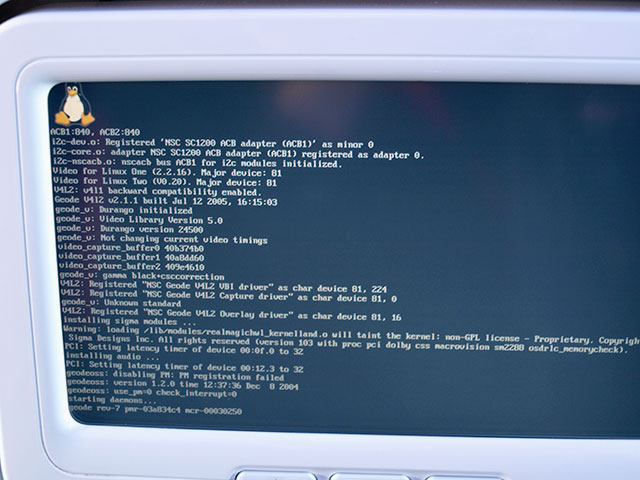
It’s running Red Hat Linux! Tux the Penguin pops up during a reboot after I crashed my inflight display. My crash didn’t affect anyone else’s console. In other respects, the fact that the system is running Linux is pretty much invisible to users. (There’s no command-line access, sorry.)
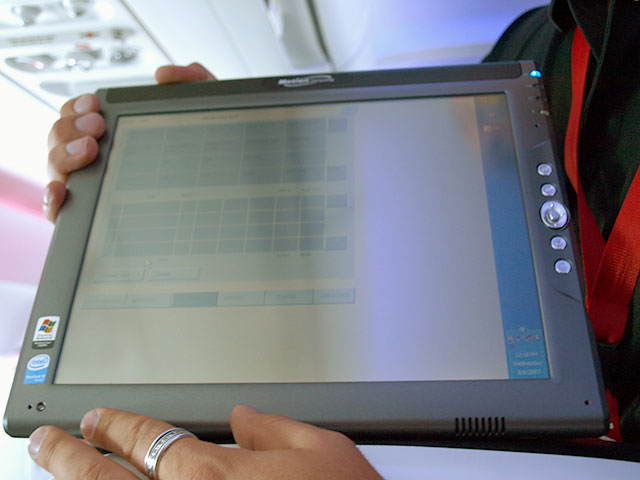
This is the control panel used by flight attendants. It shows a square for every seat on the plane. When a customer orders something on their display, the order shows up on this screen.
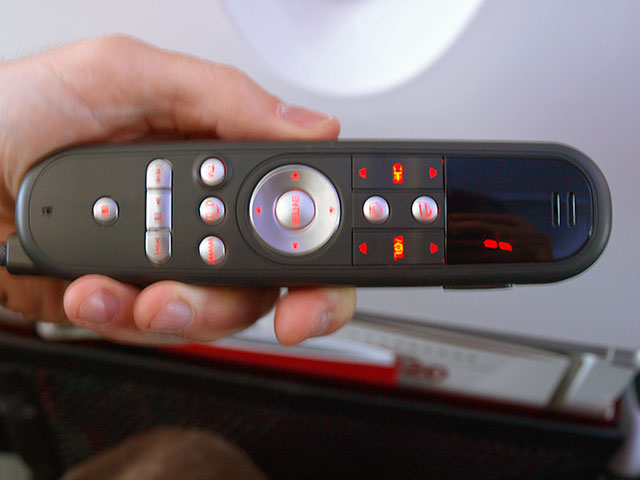
The flip side of that wired controller. (On the other side is the QWERTY keyboard.)
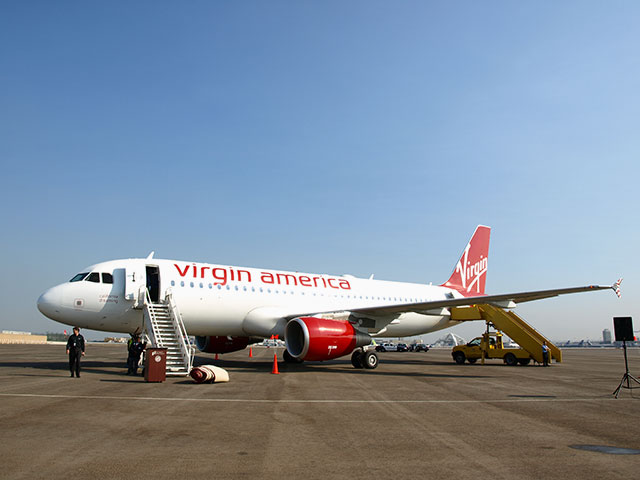
Virgin America airplane, called “California Dreamin’”, on the ground at LAX.
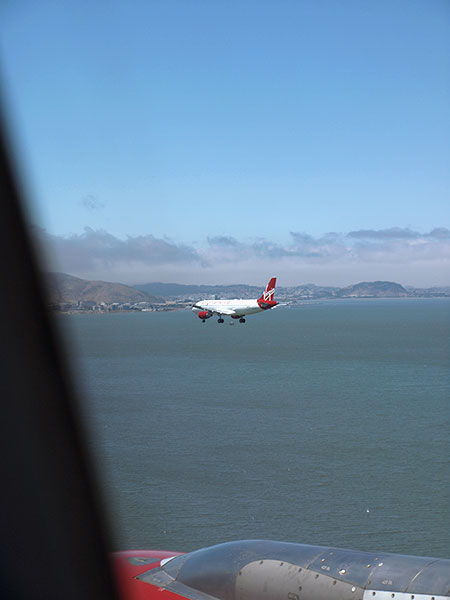
The inaugural Virgin America flight from New York’s JFK airport landed in formation with our flight, from LAX, coming in side by side at SFO. The other plane made a nice sight out the window.